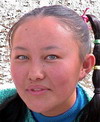BAMAD. |
BAMAD-97
Brit-Am Anthropology and DNA Update
14 August 2011, 14 Av 5771
Contents:
1.
BAMAD-97
Brit-Am Anthropology and DNA Update
Contents:
1. Question Concerning the Finnish People and DNA.
2. Genetic make-up of Europe.
3. Ancient Greeks Were Brunettes and Darkish with a Small Blonde Minority.
Racial Type of the Ancient Hellenes by Dienekes Pontikos
4.Claim that Jews Are Up to One in Twenty of Black African Ancestry?
Genes Tell Tale of Jewish Ties to Africa
Exchange Between Groups Took Place About 2,000 Years Ago by Gianna Palmer
5. Kino (from Japan) Kirghiz are mainly R1b (like western People) and descended from Manas i.e. Manasseh?
Brit-Am
Discussion Group

Contents by Subject
Research
Recognition
Reconciliation
Contribute
Site Map
Contents in Alphabetical Order

This Site
1. Question Concerning the Finnish People and DNA.
Carl Johnson wrote:
Brit-Am,
I have searched your website extensively regarding Haplogroup N3. Please forgive my total ignorance on genetics, but would you answer this one question?
It appears that science has conclusively proven that Haplogroup N3 has Asiatic origins. Although Haplogroup N3 is mapped as virtually non-existent outside the Nordic and Baltic Countries, would I be correct in assuming that due to historical migrations, Haplogroup N3 has assililated throughout the rest of Europe? (i.e., Viking Invasions) How much Finnish has shown up on autosomal DNA testing on Sweden, Britain, and Northern Germany, for example? (I believe they genetically related) Kalevi Wiik has documented that the Finnish people were the original "Old Eastern Europeans," which miscegnated with the "New Western Europeans," to become today's "Northern Europeans.
What is it? Do all North/West Europeans possess Haplogroup N3 which can only be tested by autosomal DNA? Contrary to Kalevi Wiik's research and Y-DNA...?
Map of Y-Haplogroups of Europe:
http://www.scs.illinois.edu/~mcdonald/
WorldHaplogroupsMaps.pdf
Who Are the Finns? Kalevi Wiik:
http://www.linguistics.fi/julkaisut
/SKY2006_1/1FK60.1.9.WIIK.pdf
Thanks,
Carl
Brit-Am Reply:
I looked at the URLs you sent and it did not tells us much.
Automsomal DNA tells us whom we may be related to without specifically referring to the female or male side.
If you look through our archives you will find that we have posted out quite a bit concerning the Finnish people.
We have also referred to DNA.
http://www.britam.org/countries/finland.html
DNA findings in Finland in effect help prove that DNA markers are determined by environment as much as heredity.
See:
Asian people turned into the whitest people in the world in Finland? ?
http://answers.yahoo.com/question/index?qid=20090130141920AAGCNHz
Historically:
The Finnish People may divided into several sub-groups.
One group is the Swedish one.
This includes those who now speak Swedish and many others. Perhaps 20 to 30 % of the Finns belong by ancestry to this group.
Our impression is that all early findings in Finland of habitation may be ascribed to the Lapps or to the Swedish group.
Most of the Finns may have entered Finland at a later date after ca. 500 CE.
The haplogroup N is associated with the area of Siberia and Central Asia. This is where the Finns came from and it is why they have the N Y DNA characteristic.
We doubt very much that all members of this Y haplogroup had a common ancestor.
Haplogroup N1c1
The subclade N1c1 is defined by the presence of markers M178 and P298. (It was previously known as N3a.) N1c1* has higher average frequency in Northern Europe than in Siberia, reaching frequencies of approximately 60% among Finns and approximately 40% among Latvians and Lithuanians.[24][25]
2. Genetic make-up of Europe
http://www.eupedia.com/forum/showthread.
php?25106-Genetic-make-up-of-Europe
3. Ancient Greeks Were Brunettes and Darkish with a Small Blonde Minority.
Racial Type of the Ancient Hellenes
by Dienekes Pontikos
http://dienekes.110mb.com/articles/hellenes/
Selected Extracts:
The most extensive study of modern Greeks has been carried by the Greek anthropologist Aris N. Poulianos [10,11]. Poulianos' study included the collection and study of more than seventy anthropometric measurements from a large sample of thousands of Greeks from different parts of the country. His main conclusions are that both Greeks and their neighboring populations are basically a mixture of Aegeans (a Mediterranean type local to the area) and Epirotics (Dinarics(e)) and are descended from the ancient inhabitants of the lands in which they live. The presence of individuals which approximate the Nordic subrace is minimal, and does not exceed 4-6% even in the most depigmented groups of Greece. More frequent are individuals which approximate the Alpine race of Central Europe. These reach up to 20-30% of some groups and are often blended with more southern racial types. ... J. Lawrence Angel states that 'Poulianos is correct in pointing out ... that there is complete continuity genetically from ancient to modern times.'
The American anthropologist Roland Dixon studied the funeral masks of Spartans and found them to be Alpine [23]. Italian anthropologist Raffaello Battaglia found the death masks of the Shaft Grave Mycenaeans to represent Dinaric physiognomies [35]. J. Lawrence Angel expressed similar opinions in that he believed that northern intruders in Greece were always of 'Dinaroid-Alpine central trend' [19] added to the earlier Mediterranean/Alpine blend. Racial elements were not separate but combined to produce Greek civilization [19]. Finally, a more recent statistical comparison [18] of ancient and modern Greek skulls resulted in the discovery of 'a remarkable similarity in craniofacial morphology between modern and ancient Greeks.'
Baker [5] discusses the origin of blondism and says 'It is often supposed that blondness is an indication of Nordid ancestry. Taken by itself, it is nothing of the kind.' Hence, it can be safely assumed that the existence of blond individuals in the Classical world does not require an explanation of Northern ancestry, as German anthropologist Hans Guenther [15] and the Nordicist school presumed... Carleton Coon [14] also cautions against ascribing blonde elements in Mediterranean populations to 'some invasion of Goths or Scyths, or the miscegenation of Crusaders,' noting that 'one of the characteristics of the Mediterranean race is a minority tendency to blondism.' ...Moreover The Alpine race (prevalent in much of continental Europe) has an even greater occurrence of blondism and frequently gray eyes [2]. W. W. Howells of Harvard University also notes [48] that 'Not all 'Nordics' are blond, and not all blonds are 'Nordic,' by any means.'
... Note also, that the blondest Greek group (Macedonia) has a cephalic index of 83.08, higher than the Greek average. Like in Italy [4], blondism in Greece is slightly correlated with broader heads. The opposite would be expected if it was Nordic in origin.
In conclusion, it is most likely that the minority blonde element in Greece is not necessarily associated with historical migrations. It is also true that the introduction of northern strains to the Greek population in various times from pre-history to recent times may have introduced more blond elements.
There are numerous references to brunets in ancient mythology and literature, e.g., the Muses, Poseidon, Alcmena, Theseus, Zeus, Dionysos and Odysseus are described as possessing either dark hair or dark eyes. Hercules, the Greeks' favorite hero is described as dark (melanan), hook-nosed (grupon) by Dicaearchus (Clement of Alexandria, 'Protreptic to the Greeks' 2.30.7). ..The Greek poetess Sappho (an aristocrat from the isle of Lesbos in the 7th c. BC) reveals that both she and her mother were dark (Fr. 98a, line 11). Philoktetes and Aias were also both brunet-skinned and black-haired (Malalas, Chronogr. 104, 3-8). The Spartan kings were Heraclids, claiming descent from Hercules. Similarly, Agamemnon and Menelaus, the Atreid leaders of the Achaeans in the Trojan War were descendants of Pelops, whose name means "dark-faced" [55].
... some personages (e.g., Theseus and Dionysos) are portrayed in Greek literature sometimes as blond (Euripides) and sometimes as brunet (Hesiod), indicating that there was not a uniform belief about their pigmentation. The second most popular Greek hero, Theseus, founder of Athens was dark-eyed (Bacchylides 17.16-19).
Greek art furnishes important information about the racial type of the ancient Hellenes. Coon in [4] observed that the beauty ideal of a straight nose and a lithe body was borrowed from Minoan Crete which was undisputably peopled by Mediterraneans [5,11].
Statues sometimes show traces of pigmentation; this includes different pigment types and is not uniform, representing the different hair colors among Greeks. Manzelli in a study of polychromatic Archaic Greek statuary [43] records an incidence of only 2% of yellow hair.
(f) Day [44] alleges that Manzelli miscalculates and that yellow hair is actually 7% of the total. In either case, the figure is very low, and perhaps strikingly close to the 4-6% figure of 'Nordic-like' individuals in modern Greece [10].
Manzelli also records that eye colors were black, 'red,' and brown in the majority of surviving examples, with only a single example having green eyes. Mary Stieber [47] who studied the appearance of archaic statues of young women called korai also concludes that despite the presence of light hair in some examples, 'it remains a fact that yellow hair is a rarity; for this reason alone it is tempting to infer that the percentage of its occurrence in female statues on the Acropolis is largely a reflection of its occurrence in real life.'
Theater masks also sometimes provide information about human pigmentation; this may be especially important since in theater different character types are given stereotypical features. For example, a 4th c. BC mask of a hetaira or courtesan had colour that
seems to have been black for the brows and eyelashes and red for the hair,' while 'Good Athenian girls had black hair.' [46] As will be shown below, this agrees with the ancient literary evidence which disparages hair lightening as unfit for wise women.
The Greek authors themselves never made a direct statement concerning their own racial type. It was however recognized that the Greeks were darker than the northern people whose paleness and blondness is contrasted in numerous authors with the swarthiness of the Egyptians and Ethiopians. The Hellenes believed that they represented the Golden Mean in terms of appearance. It is safe to assume that they were generally darker than Northern Europeans and lighter than Egyptians.
British archaeologist Oliver Dickinson noted that in Mycenaean art, virtually all people are drawn with dark hair and eyes [42] like ancient and modern Greeks.
4. Claim that Jews Are Up to One in Twenty (about 3% to 5%) of Black African Ancestry?
Genes Tell Tale of Jewish Ties to Africa
Exchange Between Groups Took Place About 2,000 Years Ago
http://www.forward.com/articles/140721/
By Gianna Palmer
Extracts:
In the Book of Kings, Solomon is depicted as an international businessman of sorts who sent ships from the port of Etzion-Geber, near modern day Eilat, to trade precious metals and other goods with various parts of the world, including Africa. Solomon also famously received a visit from the Queen of Sheba, who is thought to be from what is presently Ethiopia.
Now, a new scientific paper offers a genetic timeline that could support these biblical tales. The paper builds on two studies published last summer that were the first to use genome-wide analyses to trace the history of the Jewish people through DNA.
'It demonstrated that there was a biological basis for Jewishness,' said Dr. Harry Ostrer, director of the human genetics program at the New York University School of Medicine, who led one of the studies.
Among its many findings, Ostrer's paper indicated that Jews have African ancestry, an observation that David Reich, associate professor of genetics at Harvard Medical School, and his colleagues decided to explore further.
Reich's team analyzed more than half a million DNA markers across the entire genomes of people from seven diverse Jewish populations, including Ashkenazim from northern Europe; Sephardim from Italy, Turkey and Greece, and Mizrahim from Syria, Iraq and Iran. They then compared the genetic data with DNA from 15 sub-Saharan African populations.
Reporting in the April issue of PLoS Genetics, the researchers found that modern day Jews can attribute about 3% to 5% of their ancestry to sub-Saharan Africans, and that the exchange of genes between Jews and sub-Saharan Africans occurred approximately 72 generations, or about 2,000 years, ago.
Priya Moorjani, a doctoral student in Reich's lab who led the research, was surprised that the degree of African DNA was so consistent across the various Jewish populations. She had expected, for example, that North African and Middle Eastern Jews would have a greater degree of genetic mingling than Europeans, based on their geographic proximities.
So the findings, Moorjani said, may point to a shared ancestry among the various Jewish groups. 'It's definitely suggestive that most Jewish populations have a common ancestral population,' she said.
Although the Harvard team couldn't determine where exactly the exchange of genes took place, the results complement historians' understanding of the Jewish narrative.
Lawrence Schiffman, a professor of Hebrew and Judaic studies at Yeshiva University, said two time periods came to mind that could support the geneticists' findings. The first is during the First Temple Period, between about 950 B.C.E. and 600 B.C.E., when Solomon's kingdom would have had contact with Africans.
Or, Schiffman said, the mixing of populations could have taken place a bit later, during the Hellenistic period, from about 320 B.C.E. to 30 B.C.E., when Jews were living all over the southern shore of the Mediterranean Sea and could have come into contact with Africans to the south of them.
Stillman pointed out that Jews are often thought of as an insular group, because they tended to marry within their community. 'But,' he said, 'that doesn't mean there wasn't, all throughout history, an inflow of others into the group.'
As Reich sees it, genetics and history are not actually so disparate. His work, he said, is 'a kind of complementary way of studying history'.
Brit-Am Note:
It is worth remembering that according to similar studies more than 5% of North American Whites are in fact of Black African origin.
About 8% of South African Boers were of Black and Asiatic origin before the end of Apartheid and now the percentage has risen.
5. Kino (from Japan) Kirghiz are mainly R1b (like western People) and descended from Manas i.e. Manasseh?
Dear Yair Davidiy,
Hello, again.
It is said Kyrgyz men who belong to Haplogroup R1b are 63% of the male
population.
Kyrgyz were called clans of Manas. Manas was their legendary hero.
http://en.wikipedia.org/wiki/Kyrgyzstan
Manas is said to have had blue eyes and blond hair.
The site below says "O and R people stem from a relatively recent
(35,000 years) ancestor in Central Asia."
http://www.eupedia.com/forum/showthread.php?25779-The-haplogroups-hidden-behind-other-haplogroups
If R is Semitic, then probably O as well.
Is Monglian or Turkish word "Khan" related to Cohen? Khan is written
$B2D4@(B, and called Kagan as well.
Thank you for reading.
Regards,
Kino
Brit-Am Reply:
In our book
"The Khazars. Tribe 13"
http://www.britam.org/Khazarbook.html
we have noted the association of the Kirghiz with Manasseh and attributed it to Khazar influence.
Kirghiz People



Kirghiz People



Kirghiz People




Pleased with what you read'
The Brit-Am enterprise is a Biblical work.
God willing, they who assist Brit-Am will be blessed.
Brit-Am depends on contributions alongside purchases of our publications
Click Here to make an offering.
Click Here to view our publications.
'It is impossible to rightly govern the
world without
God or the Bible.'
George Washington
Brit-Am is the "still small voice" that contains the truth.
"after the earthquake a fire, but the LORD was not in the fire; and after the fire a still small voice"
[1-Kings 19:12].
PREVIOUS ISSUES
Security Cameras, Florida, USA.

The Lifestyle Doctor

Home
|
Brit-Am Discussion Group |
Contents by Subject |
Research Recognition Reconciliation Contribute |
|
Site Map Contents in Alphabetical Order |
This Site |
I have searched your website extensively regarding Haplogroup N3. Please forgive my total ignorance on genetics, but would you answer this one question?
It appears that science has conclusively proven that Haplogroup N3 has Asiatic origins. Although Haplogroup N3 is mapped as virtually non-existent outside the Nordic and Baltic Countries, would I be correct in assuming that due to historical migrations, Haplogroup N3 has assililated throughout the rest of Europe? (i.e., Viking Invasions) How much Finnish has shown up on autosomal DNA testing on Sweden, Britain, and Northern Germany, for example? (I believe they genetically related) Kalevi Wiik has documented that the Finnish people were the original "Old Eastern Europeans," which miscegnated with the "New Western Europeans," to become today's "Northern Europeans.
What is it? Do all North/West Europeans possess Haplogroup N3 which can only be tested by autosomal DNA? Contrary to Kalevi Wiik's research and Y-DNA...?
Map of Y-Haplogroups of Europe:
http://www.scs.illinois.edu/~mcdonald/
WorldHaplogroupsMaps.pdf
Who Are the Finns? Kalevi Wiik:
http://www.linguistics.fi/julkaisut
/SKY2006_1/1FK60.1.9.WIIK.pdf
Thanks,
Carl
|
|
|
|
|
|
|
|
|

Pleased with what you read'
Click Here to make an offering. |
'It is impossible to rightly govern the world without
God or the Bible.'
George Washington
Brit-Am is the "still small voice" that contains the truth.
"after the earthquake a fire, but the LORD was not in the fire; and after the fire a still small voice"
[1-Kings 19:12].
| PREVIOUS ISSUES |
 |
 |
